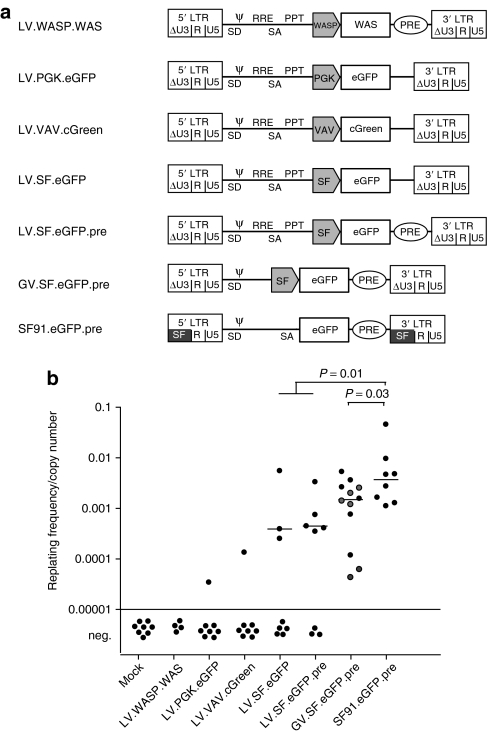Figure 1.
Transforming activity of integrating vectors depends on vector background and content. (a) Vectors tested in the in vitro immortalization (IVIM) assay in the first set of experiments. We compared the IVIM frequency of three SIN-LV with different internal promoters (SFFV, PGK, and VAV) with an LTR-driven GV (SF91.eGFP.pre) and a SIN-GV (GV.SF.eGFP.pre). The latter represents the gammaretroviral equivalent of LV.SF.eGFP.pre. We also tested a SIN-LV that expresses WASP from the WAS promoter (LV.WASP.WAS). (b) Results of the IVIM assay: plotted are the replating frequencies corrected for the mean copy number as measured in the DNA of mass cultures taken 4 days after transduction. In none of the assays performed (n = 8), we obtained replating clones from untransduced cultures (mock), whereas SF91.eGFP.pre transduced cells always led to immortalized clones (n = 8). When transducing cells with the LV.SF.eGFP (n = 8) or LV.SF.eGFP.pre (n = 8), on average, every second assay developed replating clones (reduced incidence of immortalization, P = 0.0058 Fisher's exact test). In comparison, we have plotted results obtained with the GV.SF.eGFP.pre including previously published data indicated in gray,13 and the positive control, SF91.eGFP.pre. Horizontal bars indicate the median of all positive assays for a given vector. eGFP, enhanced green fluorescent protein; LTR, long terminal repeat; neg., negative; PGK, phosphoglycerate kinase; WAS, Wiskott–Aldrich syndrome.

